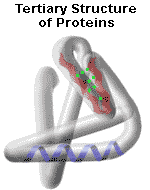Amino acids play central roles both as building blocks of proteins and
as intermediates in metabolism. The 20 amino acids that are found within
proteins convey a vast array of chemical versatility.

The
precise amino acid content, and the sequence of those amino acids, of
a specific protein, is determined by the sequence of the bases in the
gene that encodes that protein. The chemical properties of the amino acids
of proteins determine the biological activity of the protein. Proteins
not only catalyze all (or most) of the reactions in living cells, they
control virtually all cellular process. In addition, proteins contain
within their amino acid sequences the necessary information to determine
how that protein will fold into a three dimensional structure, and the
stability of the resulting structure. The field of protein folding and
stability has been a critically important area of research for years,
and remains today one of the great unsolved mysteries. It is, however,
being actively investigated, and progress is being made every day.
As we learn about amino acids, it is important to keep in mind that one
of the more important reasons to understand amino acid structure and properties
is to be able to understand protein structure and properties. We will
see that the vastly complex characteristics of even a small, relatively
simple, protein are a composite of the properties of the amino acids which
comprise the protein.
Essential amino acids
Humans can produce 10 of the 20 amino acids. The others must be supplied
in the food. Failure to obtain enough of even 1 of the 10 essential amino
acids, those that we cannot make, results in degradation of the body's
proteins—muscle and so forth—to obtain the one amino acid
that is needed. Unlike fat and starch, the human body does not store excess
amino acids for later use—the amino acids must be in the food every
day.
The 10 amino acids that we can produce are alanine, asparagine, aspartic
acid, cysteine, glutamic acid, glutamine, glycine, proline, serine and
tyrosine. Tyrosine is produced from phenylalanine, so if the diet is deficient
in phenylalanine, tyrosine will be required as well. The essential amino
acids are arginine (required for the young, but not for adults), histidine,
isoleucine, leucine, lysine, methionine, phenylalanine, threonine, tryptophan,
and valine. These amino acids are required in the diet. Plants, of course,
must be able to make all the amino acids. Humans, on the other hand, do
not have all the the enzymes required for the biosynthesis of all of the
amino acids.
Why learn these structures
and properties?
It is critical that all students of the life sciences know well the structure
and chemistry of the amino acids and other building blocks of biological
molecules. Otherwise, it is impossible to think or talk sensibly about
proteins and enzymes, or the nucleic acids.





 The
precise amino acid content, and the sequence of those amino acids, of
a specific protein, is determined by the sequence of the bases in the
gene that encodes that protein. The chemical properties of the amino acids
of proteins determine the biological activity of the protein. Proteins
not only catalyze all (or most) of the reactions in living cells, they
control virtually all cellular process. In addition, proteins contain
within their amino acid sequences the necessary information to determine
how that protein will fold into a three dimensional structure, and the
stability of the resulting structure. The field of protein folding and
stability has been a critically important area of research for years,
and remains today one of the great unsolved mysteries. It is, however,
being actively investigated, and progress is being made every day.
The
precise amino acid content, and the sequence of those amino acids, of
a specific protein, is determined by the sequence of the bases in the
gene that encodes that protein. The chemical properties of the amino acids
of proteins determine the biological activity of the protein. Proteins
not only catalyze all (or most) of the reactions in living cells, they
control virtually all cellular process. In addition, proteins contain
within their amino acid sequences the necessary information to determine
how that protein will fold into a three dimensional structure, and the
stability of the resulting structure. The field of protein folding and
stability has been a critically important area of research for years,
and remains today one of the great unsolved mysteries. It is, however,
being actively investigated, and progress is being made every day.





